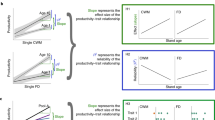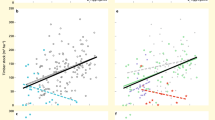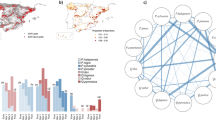Abstract
Global and local ecosystem change resulting in diversity loss has motivated efforts to understand relationships between species diversity and ecosystem services. However, it is unclear how such a general understanding can inform policies for the management of ecosystem services in production systems, because these systems are primarily used for food or fibre, and are rarely managed for the conservation of species diversity. Here, using data from a nationwide forest inventory covering an area of 230,000 km2, we show that relative abundances of commercial tree species in mixed stands strongly influence the potential to provide ecosystem services. The mixes provided higher levels of ecosystem services compared to respective plant monocultures (overyielding or transgressive overyielding) in 35% of the investigated cases, and lower (underyielding) in 9% of the cases. We further show that relative abundances, not just species richness per se, of specific tree-species mixtures affect the potential of forests to provide multiple ecosystem services, which is crucial information for policy and sustainable forest management.
This is a preview of subscription content, access via your institution
Access options
Access Nature and 54 other Nature Portfolio journals
Get Nature+, our best-value online-access subscription
$29.99 / 30 days
cancel any time
Subscribe to this journal
Receive 12 digital issues and online access to articles
$119.00 per year
only $9.92 per issue
Buy this article
- Purchase on Springer Link
- Instant access to full article PDF
Prices may be subject to local taxes which are calculated during checkout


Similar content being viewed by others
Data availability
The data that support the findings of this study are available from the corresponding author upon reasonable request.
References
Daily, G. C. Nature’s Services: Societal Dependence on Natural Ecosystems (Island Press, Washington DC, 1997).
Costanza, R. et al. Twenty years of ecosystem services: how far have we come and how far do we still need to go?. Ecosyst. Serv. 28, 1–16 (2017).
Mace, G. M., Norris, K. & Fitter, A. H. Biodiversity and ecosystem services: a multilayered relationship. Trends Ecol. Evol. 27, 19–26 (2012).
Cardinale, B. J. et al. Biodiversity loss and its impacts on humanity. Nature 486, 59–67 (2012).
Balvanera, P. et al. Linking biodiversity and ecosystem services: current uncertainties and the necessary next steps. Bioscience 64, 49–57 (2014).
Diaz, S. et al. The IPBES conceptual framework – connecting nature and people. Curr. Opin. Environ. Sustain. 14, 1–16 (2015).
Larigauderie, A. et al. Biodiversity and ecosystem services science for a sustainable planet. The DIVERSITAS vision for 2012-20. Curr. Opin. Environ. Sustain. 4, 101–105 (2012).
Gamfeldt, L. et al. Higher levels of multiple ecosystem services are found in forests with more tree species. Nat. Commun. 4, 1340 (2013).
Grime, J. P. Biodiversity and ecosystem function: the debate deepens. Science 277, 1260–1261 (1997).
Huston, M. A. Hidden treatments in ecological experiments: re-evaluating the ecosystem function of biodiversity. Oecologia 110, 449–460 (1997).
Cardinale, B. J. et al. The functional role of producer diversity in ecosystems. Am. J. Bot. 98, 572–592 (2011).
Pretzsch, H. et al. Comparison between the productivity of pure and mixed stands of Norway spruce and European beech along an ecological gradient. Ann. For. Sci. 67, 712 (2010).
Toïgo, M. et al. Overyielding in mixed forests decreases with site productivity. J. Ecol. 103, 502–512 (2015).
Felton, A. et al. Replacing monocultures with mixed-species stands: ecosystem service implications of two production forest alternatives in Sweden. Ambio 45, S124–S139 (2016).
Lu, H., Mohren, G. M. J., den Ouden, J., Goudiaby, V. & Sterck, F. J. Overyielding of temperate mixed forest occurs in evergreen-deciduous but not in deciduous-deciduous species mixtures over time in the Netherlands. For. Ecol. Manage. 376, 321–332 (2016).
Pretzsch, H. in Forest Diversity and Function 41–64 (Springer Berlin, Berlin, 2005).
de Wit, C. T. On competition. Versl. Landbouwk. Onderzoek 66, 1–82 (1960).
Trenbath, B. R. Diversity or be damned? Ecologist 5, 76–83 (1975).
Vandermeer, J. H. The Ecology of Intercropping 1st edn (Cambridge Univ. Press, Cambridge, 1989).
Schmid, B., Hector, A., Saha, P. & Loreau, M. Biodiversity effects and transgressive overyielding. J. Plant Ecol. 1, 95–102 (2008).
Nyfeler, D. et al. Strong mixture effects among four species in fertilized agricultural grassland led to persistent and consistent transgressive overyielding. J. Appl. Ecol. 46, 683–691 (2009).
Guenay, Y., Ebeling, A., Steinauer, K., Weisser, W. W. & Eisenhauer, N. Transgressive overyielding of soil microbial biomass in a grassland plant diversity gradient. Soil Biol. Biochem. 60, 122–124 (2013).
Finney, D. M., White, C. M. & Kaye, J. P. Biomass production and carbon/nitrogen ratio influence ecosystem services from cover crop mixtures. Agron. J. 108, 39–52 (2016).
Jucker, T., Bouriaud, O. & Coomes, D. A. Crown plasticity enables trees to optimized canopy packing in mixed-species forests. Funct. Ecol. 29, 1078–1086 (2015).
Kahmen, A., Renker, C., Unsicker, S. B. & Buchmann, N. Niche complementarity for nitrogen: an explanation for the biodiversity and ecosystem functioning relationship? Ecology 87, 1244–1255 (2006).
Williams, L. J., Paquette, A., Cavender-Bares, J., Messier, C. & Reich, P. B. Spatial complementarity in tree crowns explains overyielding in species mixtures. Nat. Ecol. Evol. 1, 0063 (2017).
Paquette, A. & Messier, C. The effect of biodiversity on tree productivity: from temperate to boreal forests. Glob. Ecol. Biogeogr. 20, 170–180 (2011).
Dosi, G. Technological paradigms and technological trajectories: a suggested interpretation of the determinants and directions of technical change. Res. Policy 11, 147–162 (1982).
Moen, J. et al. Eye on the Taiga: removing global policy impediments to safeguard the boreal forest. Conserv. Lett. 7, 408–418 (2014).
Blennow, K. Risk management in Swedish forestry – policy formation and fulfilment of goals. J. Risk Res. 11, 237–254 (2008).
Axelsson, A.-L. et al. in National Forest Inventories—Pathways for Common Reporting (eds Tomppo, E. et al.) 541–553 (Springer Netherlands, Dordrecht, 2010).
Haines-Young, R. & Potschin, M. B. Common International Classification of Ecosystem Services (CICES) V5.1 and Guidance on the Application of the Revised Structure (Fabis Consulting Ltd., Nottingham, 2018); https://cices.eu/
Díaz, S. et al. Assessing nature’s contributions to people. Science 359, 270–272 (2018).
Marklund, L. G. Biomass Functions for Pine, Spruce and Birch in Sweden (Department of Forest Survey, Swedish University of Agricultural Sciences, Umeå, 1988).
Petersson, H. & Ståhl, G. Functions for below-ground biomass of Pinus sylvestris, Picea abies, Betula pendula and Betula pubescens in Sweden. Scand. J. For. Res. 21, 84–93 (2006).
Miina, J., Hotanen, J. P. & Salo, K. Modelling the abundance and temporal variation in the production of bilberry (Vaccinium myrtillus L.) in Finnish mineral soil forests. Silva. Fenn. 43, 577–593 (2009).
Cederlund, G., Ljungqvist, H., Markgren, G. & Stålfelt, F. Foods of moose and roe deer at Grimsö in central Sweden—results of rumen content analysis. Swed. Wildlife Res. 11, 167–247 (1980).
Hanley, T. A. A nutritional view of understanding and complexity in the problem of diet selection by deer (Cervidae). Oikos 79, 209–218 (1997).
Boman, M., Mattsson, L., Ericsson, G. R. & Kriström, B. Moose hunting values in Sweden now and two decades ago: the Swedish hunters revisited. Environ. Resour. Econ. 50, 515–530 (2011).
Agriculture and Forestry in Sweden Since 1900 – A Cartographic Description (ed Jansson, U.) 232 (The Royal Swedish Academy of Agriculture and Forestry, Stockholm, 2011).
Warfvinge, P. & Sverdrup, H. Critical Loads of Acidity to Swedish Forest Soils: Methods, Data and Results (Department of Chemical Engineering II, Lund University, Lund, 1995).
von Arx, G., Dobbertin, M. & Rebetez, M. Spatio-temporal effects of forest canopy on understory microclimate in a long-term experiment in Switzerland. Agric. For. Meteorol. 166-167, 144–155 (2012).
Lieffers, V. J., Messier, C., Stadt, K. J., Gendron, F. & Comeau, P. G. Predicting and managing light in the understory of boreal forests. Can. J. For. Res. 29, 796–811 (1999).
Strengbom, J., Axelsson, E. P., Lundmark, T. & Nordin, A. Trade-offs in the multi-use of managed boreal forests. J. Appl. Ecol. 55, 958–966 (2018).
Joliffe, P. A. The replacement series. J. Ecol. 88, 371–385 (2000).
Bates, D. et al. Fitting linear mixed-effect models using lme4. J. Stat. Softw. 67, 1–48 (2015).
R Core Team R: A Language and Environment for Statistical Computing (R Foundation for Statistical Computing, 2017); http://www.R-project.org/
Acknowledgements
This work was supported by grant no. 942–2015–1090 from the Swedish research council Formas.
Author information
Authors and Affiliations
Contributions
All authors planned the study. L.G. and M.J. managed the data. M.J. performed the statistical analyses with support from T.S., and M.J. led the writing of the text with input from all authors.
Corresponding author
Ethics declarations
Competing interests
The authors declare no competing interests.
Additional information
Publisher’s note: Springer Nature remains neutral with regard to jurisdictional claims in published maps and institutional affiliations.
Supplementary information
Supplementary Information
Supplementary Figures 1–7 and Supplementary Tables 1–9.
Rights and permissions
About this article
Cite this article
Jonsson, M., Bengtsson, J., Gamfeldt, L. et al. Levels of forest ecosystem services depend on specific mixtures of commercial tree species. Nature Plants 5, 141–147 (2019). https://doi.org/10.1038/s41477-018-0346-z
Received:
Accepted:
Published:
Issue Date:
DOI: https://doi.org/10.1038/s41477-018-0346-z
This article is cited by
-
Impact of species composition on fire-induced stand damage in Spanish forests
Scientific Reports (2024)
-
Application of Species Diversity Theory to Quantitatively Assess the Degree of Preferential Flow in Forest Ecosystems
Journal of Soil Science and Plant Nutrition (2024)
-
A critical assessment of the biodiversity–productivity relationship in forests and implications for conservation
Oecologia (2023)
-
Joint optimization of land carbon uptake and albedo can help achieve moderate instantaneous and long-term cooling effects
Communications Earth & Environment (2023)
-
Premature losses of leaf area in response to drought and insect herbivory through a leaf lifespan gradient
Journal of Forestry Research (2022)



